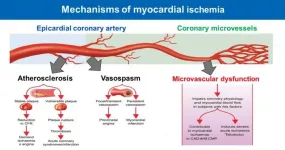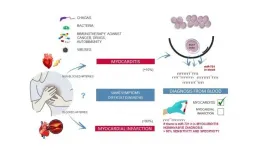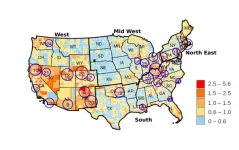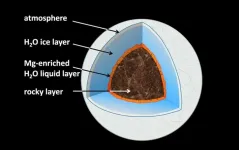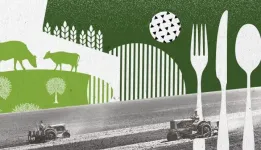Primates change their 'accent' to avoid conflict
New study finds one species will adopt another species' calls in shared territory
2021-05-27
(Press-News.org) New research has discovered that monkeys will use the "accent" of another species when they enter its territory to help them better understand one another and potentially avoid conflict.
Published in the journal Behavioral Ecology and Sociobiology, the study is the first to show asymmetric call convergence in primates, meaning that one species chooses to adopt another species' call patterns to communicate.
The study, co-authored by Dr Jacob Dunn of Anglia Ruskin University (ARU), investigated the behaviour of 15 groups of pied tamarins (Saguinus bicolor) and red-handed tamarins (Saguinus midas) in the Brazilian Amazon.
Pied tamarins are critically endangered and have one of the smallest ranges of any primate in the world, much of it around the city of Manaus, while red-handed tamarins are found throughout the north-eastern Amazon region.
The researchers found that when groups of red-handed tamarins entered territory shared with pied tamarins, the red-handed tamarins adopted the long calls used by the pied tamarins.
Red-handed tamarins have greater vocal flexibility and use calls more often than pied tamarins, and the scientists believe they might alter their calls to avoid territorial disputes over resources.
Lead author Tainara Sobroza, of the Instituto Nacional de Pesquisas da Amazonia, said: "When groups of tamarins are moving quickly around mature Amazonian forest it can sometimes be difficult to tell the species apart, but during our research we were surprised to discover they also sound the same in the areas of the forest they cohabit.
"We found that only the red-handed tamarins change their calls to those of the pied tamarins, and this only happens in places where they occur together. Why their calls converge in this way is not certain, but it is possibly to help with identification when defending territory or competing over resources."
Co-author Dr Jacob Dunn, Associate Professor in Evolutionary Biology at Anglia Ruskin University (ARU), said: "We have long known that when closely related species overlap in their geographic ranges, we are likely to see interesting evolutionary patterns. One famous example is the Galapagos finches, studied by Darwin, whose beaks evolved to specialise on different foods on the islands to avoid competition.
"In some cases, rather than diverging to become more different from one another, some closely related species converge to show similar traits. Our study is the first to show asymmetric call convergence in primates, with one species' call becoming the 'lingua franca' in shared territories.
"Because these tamarin species rely on similar resources, changing their 'accents' in this way is likely to help these tiny primates identify one another more easily in dense forest and potentially avoid conflict."
INFORMATION:
[Attachments] See images for this press release:
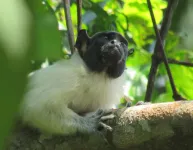
ELSE PRESS RELEASES FROM THIS DATE:
2021-05-27
For the first time, a prospective, international study has shown that chest pain caused by problems with the very small vessels supplying blood to the heart is an important health problem that increases the risk of heart attacks, stroke and death due to cardiovascular reasons.
The study, which is published today (Thursday) in the European Heart Journal [1], recruited 686 patients from 14 institutions in seven countries on four continents [2] between July 2015 and December 2018 to investigate microvascular angina (MVA). Until now, MVA was widely thought to be a benign disease that mainly occurs in women. However, the ...
2021-05-27
Half a billion tonnes of carbon emissions could be cut from Earth's atmosphere by improved management of peatlands, according to research partly undertaken at the University of Leicester.
A team of scientists, led by the UK Centre for Ecology and Hydrology (UKCEH), estimated the potential reduction of around 500 million tonnes in greenhouse gas (GHG) emissions by restoring all global agricultural peatlands.
Peatlands - a type of wetland, where dead vegetation is stopped from fully breaking down - cover just 3% of the global land surface, but store around 650 billion tonnes of ...
2021-05-27
Highlights
Among patients receiving dialysis in the Southeastern United States, those at for-profit dialysis facilities were less likely to be referred for kidney transplantation than those at non-profit facilities.
Rates of starting medical evaluations soon after referral and placing patients on a waitlist after evaluations were similar between the groups.
Washington, DC (May 26, 2021) -- New research indicates that patients with kidney failure who receive care at for-profit dialysis facilities are less likely to be referred for kidney transplants that those receiving care at non-profit ...
2021-05-27
Scientists at the Centro Nacional de Investigaciones Cardiovasculares (CNIC) have identified the first blood biomarker for myocarditis, a cardiac disease that is often misdiagnosed as myocardial infarction. Nevertheless, the diagnosis of myocarditis continues to be challenging in clinical practice.
The study, led by Dr. Pilar Martín and published today in The New England Journal of Medicine, has detected the presence of the human homolog of micro RNA miR-721 in the blood of myocarditis patients.
CNIC General Director Dr. Valentín Fuster emphasizes that these results of paramount importance because they establish the first validated blood marker with high sensitivity and specifity (>90%) for myocarditis. This will allow ...
2021-05-27
Continuous skin-to-skin contact starting immediately after delivery even before the baby has been stabilised can reduce mortality by 25 per cent in infants with a very low birth weight. This according to a study in low- and middle-income countries coordinated by the WHO on the initiative of researchers at Karolinska Institutet published in The New England Journal of Medicine.
Continuous skin-to-skin contact between infant and mother, or "Kangaroo Mother Care" (KMC), is one of the most effective ways to prevent infant mortality globally. The current recommendation from the World Health Organization (WHO) is that skin-to-skin contact should commence ...
2021-05-26
ITHACA, N.Y. - Soil carbon storage, carbon capture and storage, biochar - mention these terms to most people, and a blank stare might be the response.
But frame these climate change mitigation strategies as being clean and green approaches to reversing the dangerous warming of our planet, and people might be more inclined to at least listen - and even to back these efforts.
A cross-disciplinary collaboration led by Jonathon Schuldt, associate professor of communication at Cornell University, found that a majority of the U.S. public is supportive of soil carbon storage as a climate change mitigation strategy, particularly when that and similar approaches are seen as "natural" strategies.
"To me, that psychology part - that's really interesting," Schuldt ...
2021-05-26
With brilliant colors and picturesque shapes, many crystals are wonders of nature. Some crystals are also wonders of science, with transformative applications in electronics and optics. Understanding how best to grow such crystals is key to further advances.
Scientists from the U.S. Department of Energy's (DOE) Argonne National Laboratory, along with three universities, have revealed new insights into the mechanism behind how gallium nitride crystals grow at the atomic scale.
Gallium nitride crystals are already in wide use in light-emitting diodes, better known as LEDs. They might also be applied to form transistors for high-power switching electronics to make electric grids more energy efficient and smarter. The use of such "smart grids," which ...
2021-05-26
The opioid epidemic is taking a deadly toll on people in disproportionate clusters from Cape Cod to San Diego, according to a new study by the University of Cincinnati.
Fatal opiate overdoses are most prevalent among six states: Ohio, Pennsylvania, Kentucky, West Virginia, Indiana and Tennessee. But researchers identified 25 hot spots of fatal opioid overdoses nationwide using data from the Centers for Disease Control and Prevention.
The study demonstrates how both widespread and localized the problem of substance use disorders can be, UC assistant professor and co-author Diego Cuadros ...
2021-05-26
What is happening deep beneath the surface of ice planets? Is there liquid water, and if so, how does it interact with the planetary rocky "seafloor"? New experiments show that on water-ice planets between the size of our Earth and up to six times this size, water selectively leaches magnesium from typical rock minerals. The conditions with pressures of hundred thousand atmospheres and temperatures above one thousand degrees Celsius were recreated in a lab and mimicked planets similar, but smaller than Neptune and Uranus.
The mechanisms of water-rock interaction at the Earth's surface are well known, and the picture of ...
2021-05-26
Modern-day agriculture faces two major dilemmas: how to produce enough food to feed the growing human population and how to minimize environmental damage associated with intensive agriculture. Keeping more nitrogen in soil as ammonium may be one key way to address both challenges, according to a new paper in the Proceedings of the National Academy of Sciences (PNAS).
Today's use of nitrogen fertilizers contributes heavily to greenhouse gas emissions, air pollution, and water pollution, but they are also essential for growing crops. Reducing this pollution is critical, but nitrogen use is likely to grow with increased food production. At ...
LAST 30 PRESS RELEASES:
[Press-News.org] Primates change their 'accent' to avoid conflict
New study finds one species will adopt another species' calls in shared territory

